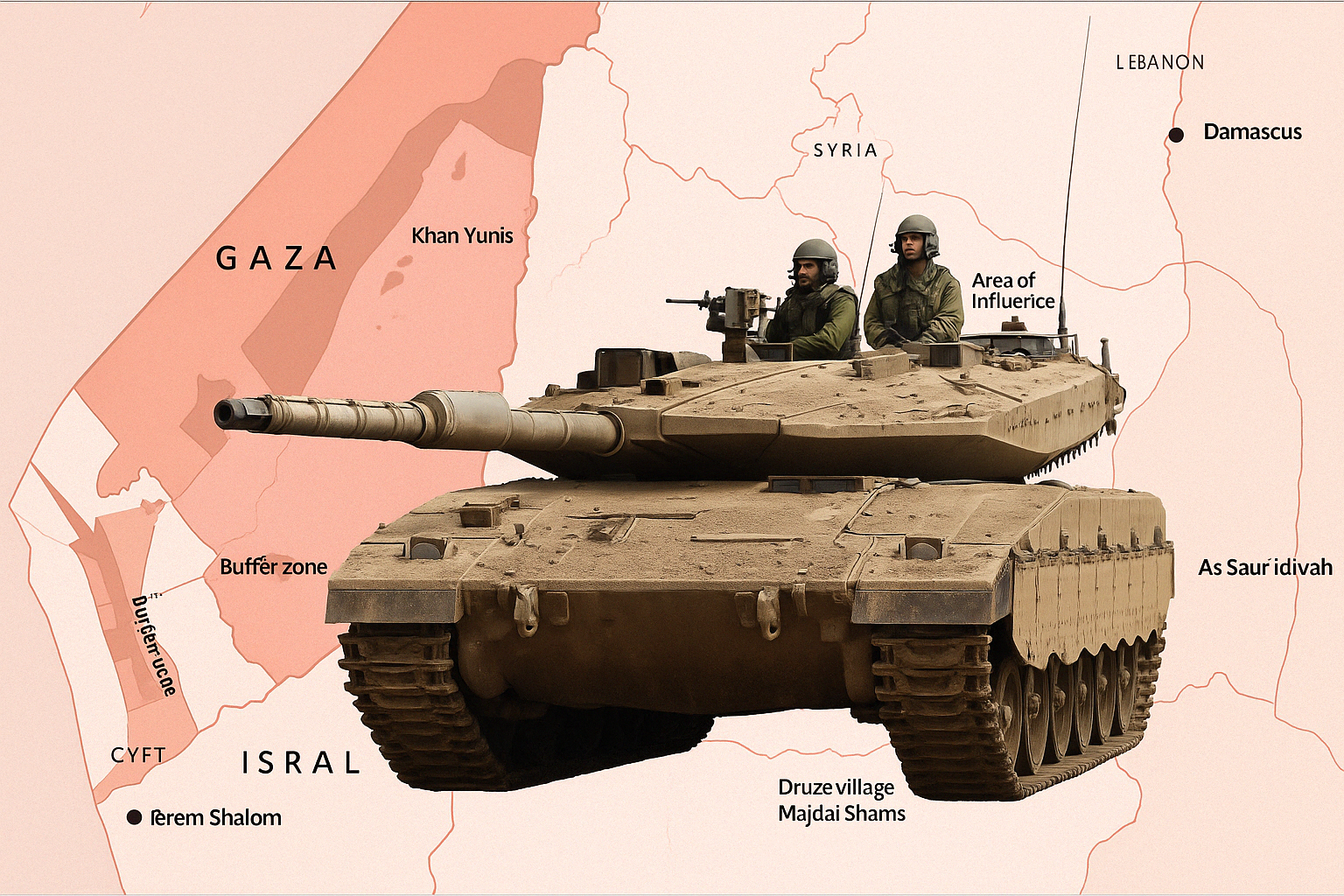How October 7 reshaped Israel’s regional strategy — and what it means for the future of the Middle East
Introduction
In the aftermath of the October 7, 2023 Hamas attack, Israel has launched a sweeping military strategy that is quietly redrawing the map of the Middle East. With operations expanding into Syria, Lebanon, Gaza, and the West Bank, the country is shifting from a reactive defense posture to a proactive, territorially grounded security doctrine. This new approach is not only altering regional dynamics — it’s also challenging long-standing international norms.
A New Phase of Israeli Strategy
Israel’s current military operations are no longer limited to defensive tactics. In Gaza, the Israeli Defense Forces (IDF) are building a 1-kilometer-wide buffer zone. In southern Lebanon, Israeli troops have established and maintained fortified outposts. In Syria, hundreds of square kilometers have been seized following the collapse of Bashar al-Assad’s regime.
Military officials describe this as a long-term “strategic posture” designed to neutralize threats before they materialize. Unlike the episodic campaigns of the past, these deployments appear indefinite — and in some cases, permanent.
Gaza: A Buffer Zone or De Facto Partition?
The Gaza Strip has become the focal point of Israel’s evolving strategy. Following the October 7 attack, Israel resumed its offensive after a brief ceasefire. Since then, large portions of southern Gaza have been reduced to rubble, and a permanent buffer zone is in development.
Officials claim the buffer zone is essential for preventing future attacks. Critics argue that it serves a dual purpose: separating populations and paving the way for long-term demographic changes — a concern intensified by speculation over transforming Gaza into a tourism hub, reportedly backed by U.S. President Donald Trump.
Syria: Preemptive Occupation Amid Collapse
In late 2024, following the fall of Damascus to Islamist-led rebels, Israel launched a series of coordinated operations across its northeastern frontier. Mount Hermon, the Golan Heights, and the formerly UN-monitored demilitarized zone have all come under Israeli control.
Officials have extended the security perimeter deep into Syrian territory, with airstrikes even reaching Syrian air bases far from the border. These actions mark a preemptive approach: secure now, neutralize later. Some analysts warn of an emerging insurgency in Syria’s south, but the Israeli view is clear — presence equals deterrence.
Lebanon: A Strategy of Forward Defense
Despite a ceasefire in late 2024, Israel continues to strike Hezbollah positions daily. IDF troops have established five outposts inside southern Lebanon, which they argue are vital to the return of Israeli civilians displaced by earlier clashes.
The strategy is reminiscent of Israel’s 1982–2000 occupation of southern Lebanon. However, while that occupation ended in withdrawal and the rise of Hezbollah, current officials maintain that proactive positioning is essential to prevent a similar threat from reemerging.
Lebanese leaders, meanwhile, accuse Israel of violating sovereignty and international law.
West Bank: Internally Redefined Borders
Simultaneously, the West Bank is undergoing a transformation. The IDF has razed large portions of Jenin, Tulkarm, and Nur Shams refugee camps — all areas under Palestinian Authority control — and replaced them with military outposts.
Unlike past raids, these new deployments appear designed for permanence. The UN estimates over 40,000 Palestinians have been displaced. Israeli officials call this a necessary move to dismantle militant networks. But critics point out that it significantly alters the internal territorial status quo, raising questions about future governance and autonomy.
Implications: Security or Instability?
Israel’s actions have drawn condemnation from neighboring states, international legal experts, and human rights groups. Syria and Lebanon have issued official protests. Analysts warn that long-term military occupation may increase regional volatility.
Supporters of the doctrine argue that the events of October 7 revealed deep flaws in Israel’s previous security model. They say territorial control, not reactive defense, is the only path to lasting peace in a region marked by collapsing states and non-state militant threats.
Conclusion
What’s unfolding is more than a military campaign — it’s a fundamental rethinking of borders, sovereignty, and strategic depth. Whether this new doctrine will lead to stability or perpetual confrontation is unknown. What is certain, however, is that Israel’s security map is being redrawn in real time.
The question now facing the region — and the world — is not just how to respond, but whether the very rules of engagement have changed for good.



